一、线程的基本概念:
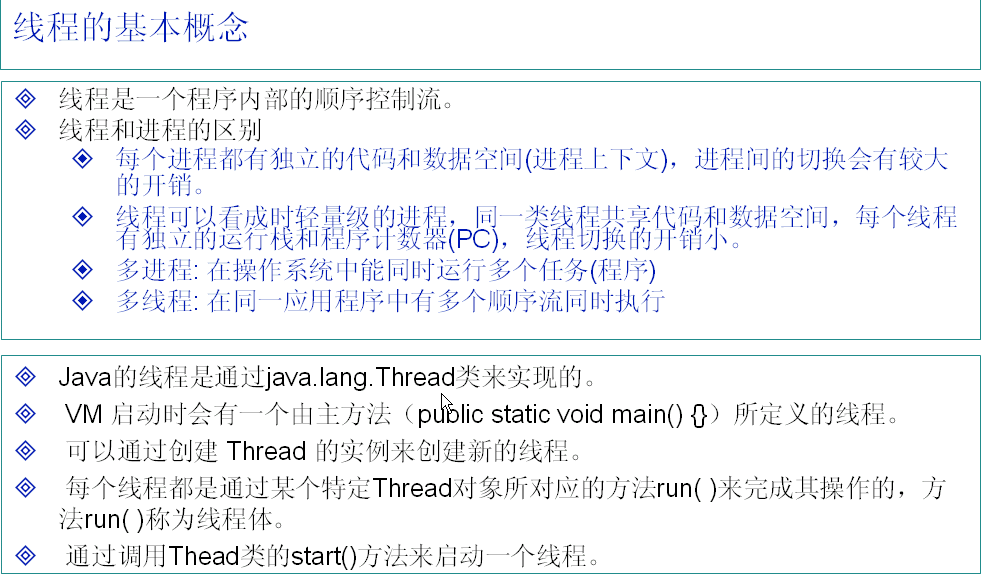
线程是一个程序里面不同的执行路径。
程序里面不同的执行路径,每一个分支都是一个线程。
进程:静态的概念。机器上的一个class文件,机器上的一个exe文件,这叫一个进程。
机器里面实际上运行的都是线程。
window等。linux等都是多进程,多线程的系统。
CPU的执行是这样的:
CPU速度比较快,一秒钟算好几亿次,它把自己的时间分成一个一个的小时间片,这个时间片我执行你一会,再执行他一会,虽然有几十个线程,
没关系,执行这个一会,执行那个一会,挨着排的都执行一遍,但是对我们人来说,因为它速度太快了,你看起来就好像好多线程在同时执行一样。
但实际上,在一个时间点上, 这个CPU只有一个线程在运行。
如果机器是双CPU,或者是双核,那么确实是多线程。
二、线程的启动和创建:
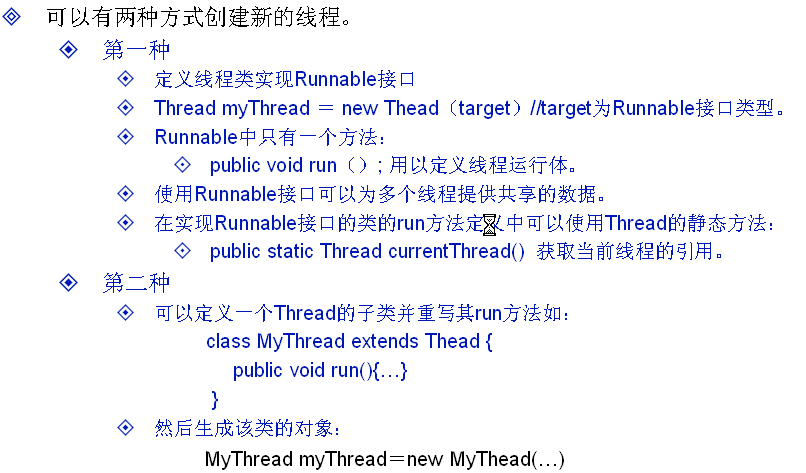
例子1:实现Runnable接口:
package com.cy.thread;public class TestThread1 {public static void main(String[] args) {Runner1 r = new Runner1();Thread t = new Thread(r);//启动一个线程,线程启动必须调用Thread类的start()方法//start方法会通知cpu,我现在有个新线程了啊,已经准备好了,您老人家什么时候有时间赶紧给我点时间片。 t.start();for(int i=0; i<100; i++){System.out.println("Main Thread:----- " + i);}} }/*** 实现了Runnable之后,jdk就知道了,这是一个线程类。*/ class Runner1 implements Runnable{@Overridepublic void run() {for(int i=0; i<100; i++){System.out.println("Runner1: " + i);}}}
console:
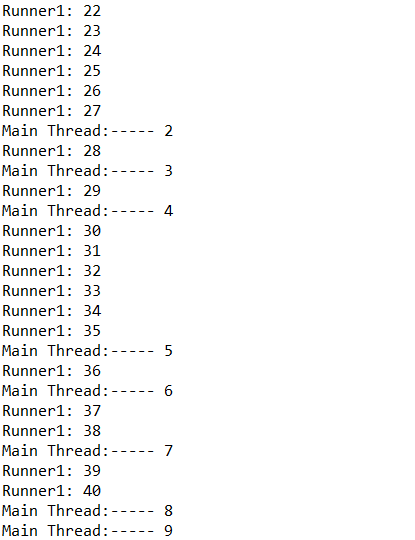
例子2:继承Thread类:
package com.cy.thread;public class TestThread1 {public static void main(String[] args) {Runner1 r = new Runner1();r.start();for(int i=0; i<100; i++){System.out.println("Main Thread:----- " + i);}} }class Runner1 extends Thread{@Overridepublic void run() {for(int i=0; i<100; i++){System.out.println("Runner1: " + i);}}}
三、线程的状态转换:
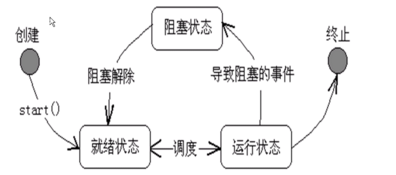
new Thread()一个线程之后,不会马上执行而是进入就绪状态,因为cpu很忙,可能正在执行其他程序;
等到cpu有空了,cpu分配时间片执行(调度)这个Thread一会;Thread进入运行状态;
当cpu分配给这个Thread的时间片用完了,或者其他原因故障等,Thread不再执行,阻塞,再次进入就绪状态;
直到这个Thread的程序执行完毕;终止。
四、线程控制的基本方法:


isAlive(): 判断线程是否还活着,即线程是否还未终止;就绪、运行、阻塞叫活着。终止了就死了。线程创建完还没启动那也是死的。
getPriority() 获得线程的优先级数值;优先级越高的线程获得的cpu执行的时间越多。
setPriority() 设置线程的优先级数值;
Thread.sleep() 将当前线程睡眠指定毫秒数。
join() 合并某个线程。
yield() 高风亮节,让出cpu,让其他的线程执行,而自己进入就绪状态。
wait() 当前线程进入对象的wait pool;
notify、notifyAll() 唤醒对象的wait pool中的一个/所有等待线程。
五、sleep方法:


package com.cy.thread;import java.util.Date;public class TestInterrupt {public static void main(String[] args) {MyThread thread = new MyThread();thread.start();try {/*** 在哪个线程里面调用sleep方法,就让哪个线程睡眠。*/Thread.sleep(10000);} catch (InterruptedException e) {e.printStackTrace();}/*** interrupt()方法:thread线程在睡眠的时候,将它打断。* 这里为了例子演示,让子线程结束。* 但这不是让子线程结束的最好方法。*/thread.interrupt();} }class MyThread extends Thread{@Overridepublic void run() {while(true){System.out.println("==="+new Date()+"===");try {sleep(1000);} catch (InterruptedException e) {return;}}} }
console打印:

上面的程序提供一个结束Mythread线程的方法:


/*** 提供一个让线程结束的方法:* thread.flag = false; run()方法就不再执行了,run方法一结束,线程就结束了。*/ class MyThread2 extends Thread{boolean flag = true;@Overridepublic void run() {while(flag){System.out.println("==="+new Date()+"===");try {sleep(1000);} catch (InterruptedException e) {return;}}} }
六、join方法:


package com.cy.thread;public class TestJoin {public static void main(String[] args) {MyThread2 t1 = new MyThread2("t1");t1.start();try {/*** 将t1线程合并到main线程,和main线程一块执行。*/t1.join();} catch (InterruptedException e) {e.printStackTrace();}for(int i=0; i<=5; i++){System.out.println("i am main thread");}} }class MyThread2 extends Thread{MyThread2(String s){super(s);}@Overridepublic void run() {for(int i=0; i<=5; i++){System.out.println("i am " + getName());try{sleep(1000);}catch(InterruptedException e){return;}}}}
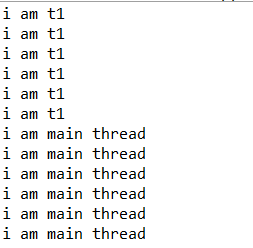
七、yield方法:
执行到某一个点的时候,让出CPU,其他的线程有机会执行,不要说老让我自己一个人占着;
但是我就让一下,不是说从此我就不再执行了;


package com.cy.thread;public class TestYield {public static void main(String[] args) {//可以使用同一个线程类,new两个线程。MyThread3 t1 = new MyThread3("t1");MyThread3 t2 = new MyThread3("t2");t1.start();t2.start();} }class MyThread3 extends Thread{MyThread3(String s){super(s);}@Overridepublic void run() {for(int i=0; i<=100;i++){System.out.println(getName() + ": " +i);if(i%10 == 0){yield();}}} }
观察输出,可以看到,每当被10整除后,下一个输出的一定是另外一个线程的。
八、线程的优先级:
Java提供一个线程调度器来监控程序中启动后进入就绪状态的所有线程。
线程调度器按照线程的优先级决定应调度哪个线程来执行。
线程的优先级用数字表示,范围从1-10,一个线程默认的优先级是5;
Thread.MIN_PRIORITY = 1;
Thread.MAX_PRIORITY = 10;
Thread.NORM_PRIORITY = 5;
使用下述方法获得或设置线程对象的优先级:
int getPriority();
void setPriority(int newPriority); 

package com.cy.thread;public class TestPriority {public static void main(String[] args) {Thread t1 = new Thread(new T1());Thread t2 = new Thread(new T2());t1.setPriority(Thread.NORM_PRIORITY + 3);t1.start();t2.start();} }class T1 implements Runnable{@Overridepublic void run() {for(int i=0; i<1000; i++){System.out.println("T1: " + i);}} }class T2 implements Runnable{@Overridepublic void run() {for(int i=0; i<1000; i++){System.out.println("----T2: " + i);}} }
可以看到,t1得到cpu执行的时间片多,开始打印的都是t1,少部分t2。等到t1执行完了,才开始都是t2.
---------------
